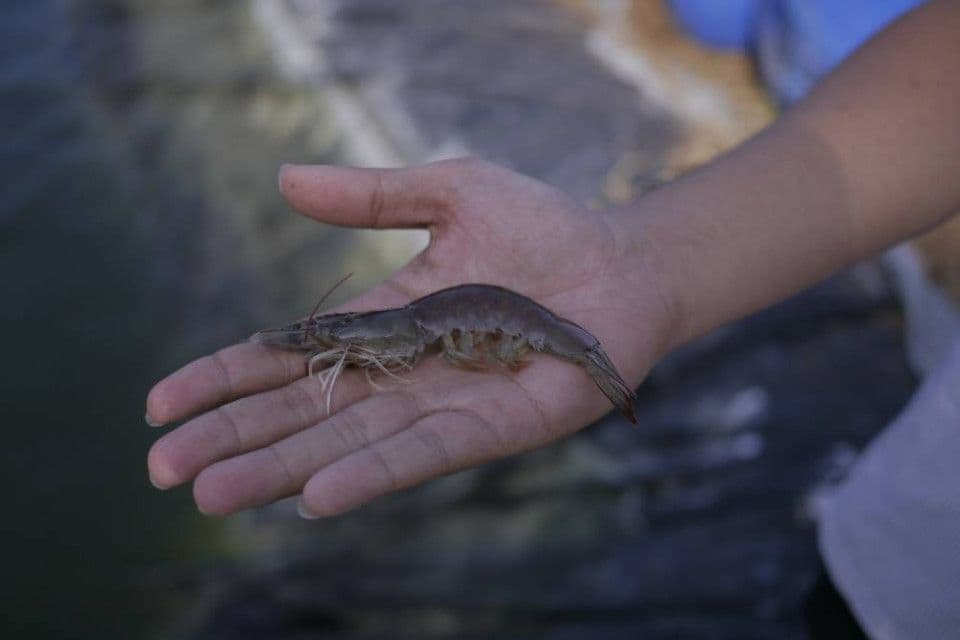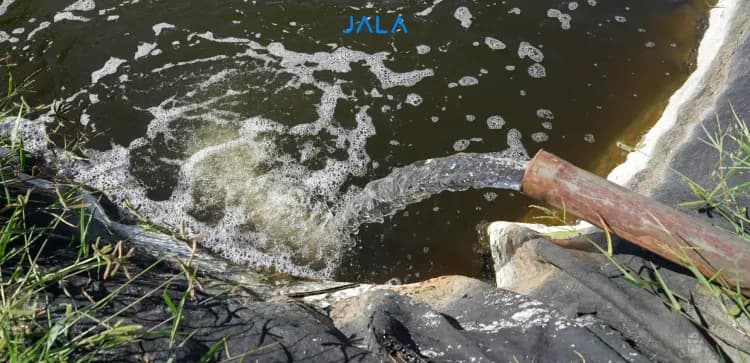
Vibrio bacteria is the major threat lurking in shrimp farming besides viruses. Its presence harms shrimp and may cause a number of deadly diseases when the density is > 10⁴ CFU/mL. If left untreated, this disease will cause mass shrimp deaths and lead to economic losses for farmers.
What is Vibrio Bacteria?
Vibrio sp. or vibrio bacteria are pathogenic bacteria that live in waters and often infect vannamei shrimp. Some of the species include
- Vibrio harveyi
- Vibrio vulnificus
- Vibrio anguillarum
- Vibrio alginolyticus
- Vibrio parahaemolyticus
- Vibrio fluvialis
Vibrio bacteria are opportunistic, meaning that they are in a normal state in the rearing environment, but can turn from saprophytic to pathogenic when the circumstances enable them to do so (Tjahjadi, 1994 in Sazali, 2008). This bacterial outbreak will worsen if the shrimp density and surrounding conditions are not favorable.
What is Vibriosis in Shrimp?
Vibriosis in shrimp is a deadly disease caused by gram-negative Vibrio sp., such as Vibrio parahaemolyticus and Vibrio alginolyticus. In the larvae or juvenile stages, this disease can result in up to 100% mortality.
Shrimp body parts that are usually affected by Vibriosis are the digestive tissue, such as the hepatopancreas and stomach. This disease can also be detected by isolating bacteria from the body of infected shrimp then planting it on agar medium that is selective for vibrios, namely the TCBS agar (Sazali, 2008).
Symptoms of Shrimp Infected by Vibrio Bacteria
Shrimp infected by vibrio bacteria usually show changes in behavior and physical symptoms. Here are the signs:
1. Shrimp appetite decreases
Decreasing appetite is one of the signs that shrimp are being infected by vibrio bacteria. There will be a lot of feed left behind when farmers check on the feeding trays, which suggests that shrimp did not consume much of the feed given.
2. Shrimp appear weak
Shrimp that appear weak are the result of decreasing appetite. When infected by vibrio bacteria, shrimp will move passively, swim sideways, and approach the water’s surface.
3. Shrimp look pale
Shrimp with vibrio infection usually have pale bodies. This is caused by tissue damage in their bodies.
4. The shrimp’s bodies emit light
This symptom is usually shown by shrimp infected by Vibrio harveyi bacteria. A light will be emitted on the shrimp’s bodies when their surrounding environment is dark.
Shrimp Disease Caused by Vibrio Bacteria
Apart from the symptoms above, shrimp infected with disease caused by vibrio bacteria also show some specific symptoms. The following are two dangerous diseases that are caused vibrio:
White Feces Diseases (WFD)
Vibrio parahaemolyticus in shrimp may cause WFD. The emergence of white excrement or feces from shrimp that float in the pond is the indication of WFD symptoms. This feces is a collection of damaged, decaying shrimp digestive tissue, which then form aggregates that unites with the feces.
These aggregates resemble gregarine, thus the diagnosis of the cause of this disease was initially gregarine. However, further research revealed a strong association with the presence of Vibrio bacteria. There are also other indications that WFD is stimulated by Blue Green Algae (BGA) blooming. One of the toxins produced by BGA, hepatotoxin, also damages the hepatopancreas of shrimp, resulting in white feces.
Read further: Causes and Mitigation Steps of Blooming Algae in Shrimp Farms: Farmers Should Be Aware
In addition, stressed shrimp are more susceptible to disease. Stress may result from declining water quality. Water quality requires great attention to prevent BGA blooming and disturbance for shrimp to grow healthily.
Acute Hepatopancreatic Necrosis Disease (AHPND)
Under severe conditions, AHPND causes mortality at the beginning of cultivation, namely around day 35 to 45. It even occurs now before the cultivation period reaches 30 days with a mortality rate of 40-100% in 4 days. When shrimp are infected by AHPND, their hepatopancreas shrinks and their intestine becomes empty, a condition known as necrosis.
Meanwhile, the term Early Mortality Syndrome (EMS) which is associated with AHPND is actually not a disease but only a technical form of AHPND, and its strongest cause is Vibrio parahaemolyticus (Zorriehzahra dan Banaederakhshan, 2015).
Shrimp with severe levels of AHPND will die at the beginning of the cultivation phase, 10-30 days after stocking with a mortality rate of up to 100%. Mortality due to EMS occurs when the temperature in the environment is high.
EMS is feared by shrimp farmers all over the world. This syndrome is indicated by premature death of shrimp, even 30 days after stocking. In 2009, it began to spread from China to other parts of Asia. However, research is still ongoing to determine the cause for sudden death.
In addition to the presence of white feces, other symptoms that can be used to diagnose this disease include a shrinking pancreas, empty intestines, decreased appetite, and slowed growth. Farmers are advised to confirm the presence of this disease by bringing shrimp and sediment samples for laboratory testing.
How to Prevent Vibrio Bacteria in Shrimp Farms
After understanding what vibrio bacteria are and their symptoms, you also need to know how to prevent them from growing in ponds. The following are some measures you can implement:
1. Maintain water quality stability
Fluctuating water stability will increase the risk of disease in shrimp. If water quality parameter values frequently change, shrimp will be prone to stress and susceptible to disease. Therefore, it is important to maintain water quality to keep it stable and ideal.
2. Use high quality shrimp fry
Using high quality shrimp fry is one of the essential measures in cultivation. Healthy shrimp fry with SPF (Specific Pathogen Free) certificate will better guarantee the health of the shrimp.
3. Implement proper sanitation
Sanitation is part of biosecurity implementation. This measure aims to prevent pathogenic bacteria (vibrio) from entering the farm area and infecting the shrimp. This is carried out by ensuring that all farm personnel are clean and that the pond equipment is free from disease germs.
4. Control quorum sensing
Quorum sensing is a communication system between vibrio bacteria that aims to activate the expression of certain genes, in this case pathogenic traits. The risk of disease can be minimized by conducting quorum sensing control.
5. Apply probiotics
Probiotics serve to break down organic materials into simple chemical compounds, making it easier to be naturally decomposed. This way of working can suppress the vibrio population in ponds and prevent shrimp from harmful diseases.
Conclusion
Vibrio is an opportunistic pathogenic bacteria that often infect shrimp. AHPND and WFD are diseases that are caused by this bacteria, while vibriosis in shrimp can be caused by gram-negative vibrio bacteria.
Symptoms of vibrio infection in shrimp usually include the following:
- Shrimp appetite decreases
- Shrimp appear weak
- Shrimp look pale
- A light appears on shrimp body in dark conditions
To prevent vibrio bacteria from emerging, you can do the following measures:
- Maintain water quality
- Use high quality shrimp fry
- Implement proper sanitation
- Control quorum sensing
- Apply probiotics
In addition, you also need to record every time any disease symptoms or vibrio indications appear. You can record it conveniently in JALA App, a shrimp farm management app from JALA.
Explore numerous advantages of cultivating with JALA App! Sign up at app.jala.tech or download the app on Google Play Store or App Store.

References
Kupas Strategi Penanganan Vibriosis pada Udang | Trobos Aqua
Tjahjadi, M. R. (1994). Bakteri Penghambat Vibrio harveyi untuk Menanggulangi dan Penyakit Berpendar pada Larva Udang Windu (Penaeus monodon). (undergraduate thesis). in Sazali, S. (2008). (rep.). Skrining Bakteri Vibrio sp. Penyebab Penyakit Udang Berbasis Teknik Sekuens 16S rDNA. Pekanbaru, Riau: Riau University.
Penting! Mengenal Bakteri Vibrio | JALA
Zorriehzahra, M. J., & Banaederakhshan, R. (2015). Early mortality syndrome (EMS) as new emerging threat in shrimp industry. Advances in Animal and Veterinary Sciences, 3(2s), 64–72. https://doi.org/10.14737/journal.aavs/2015/3.2s.64.72





